It is only by chance I came across this story whilst I was researching the Katyn Massacre in Poland, it was only one letter of a difference but both atrocities portrayed the human depravity.
https://dirkdeklein.wordpress.com/2016/04/13/katyn-forest-massacre-the-killing-of-polish-pows/
Khatyn or Chatyń (Belarusian and Russian: ) was a village of 26 houses and 156 inhabitants in Belarus, inLahoysk Raion, Minsk Region, 50 km away from Minsk. On 22 March 1943, the entire population of the village was massacred by the 118th Schutzmannschaft Nazi battalion. The battalion was formed in July 1942 in Kiev and was made up mostly of Ukrainian nationalist collaborators from Western Ukraine, Hiwis and the Dirlewanger Waffen-SS special battalion.
The massacre was not an unusual incident in Belarus during World War II. At least 5,295 Belarusian settlements were burned and destroyed by the Nazis, and often all their inhabitants were killed (some amounting up to 1,500 victims) as a punishment for collaboration with partisans. In the Vitebsk region, 243 villages were burned down twice, 83 villages three times, and 22 villages were burned down four or more times. In the Minsk region, 92 villages were burned down twice, 40 villages three times, nine villages four times, and six villages five or more times.Altogether, over 2,000,000 people were killed in Belarus during the three years of Nazi occupation, almost a quarter of the region’s population.
On 22 March 1943, a German convoy was attacked by Soviet partisans
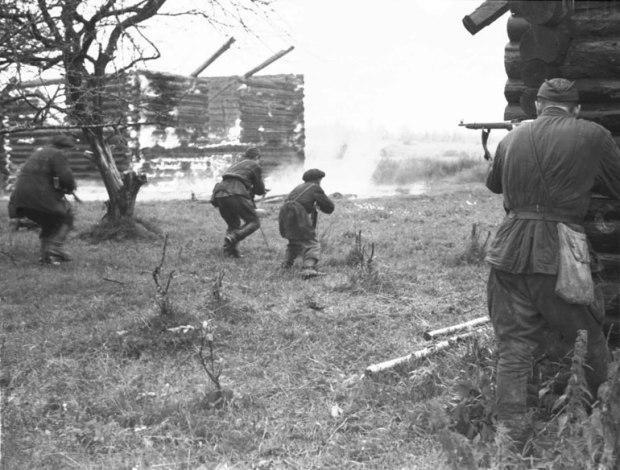
near Koziri village just 6 km away from Khatyn, resulting in the deaths of four police officers of Schutzmannschaft Batallion 118, which consisted mostly of Ukrainian collaborators, and Red Army prisoner-of-war volunteers and deserters. Among the dead was Hauptmann Hans Woellke.

The battalion’s commanding officer.Woellke was an Olympic champion in Berlin in 1936 and an acquaintance of Adolf Hitler.
Troops from the Dirlewanger Brigade,a unit mostly composed of criminals recruited for anti-partisan duties, entered the village and drove the inhabitants from their houses and into a shed, which was then covered with straw and set on fire. The trapped people managed to break down the front doors, but in trying to escape, were killed by machine gun fire. 147 people, including 75 children under 16 years of age, were killed – burned, shot or suffocated in fire. The village was then looted and burned to the ground.
Only eight inhabitants of the village survived, from whom six were recognized as witnesses to the tragedy – five children and a single adult. By 2008, only two of them were still alive to tell the story
Twelve-year-old Anton Iosifovich Baranovsky , was left for dead due to wounds in both legs.His injuries were treated by partisans.

Alexander Petrovich Zhelobkovich (1930–1994), who was 12 years old at the time, also survived. When the Nazi soldiers almost surrounded the village, his mother woke him up and put him on a horse, on which he escaped to a nearby village.
Vladimir Antonovich Yaskevich managed to survive by hiding in a potato pit 200 meters from his family house. Two Nazi soldiers noticed the boy, yet they spared him. Vladimir noted that they spoke German between themselves, not Ukrainian.
Sofia Antonovna Yaskevich,(later Fiokhina) Vladimir’s sister (born 1934) hid in the cellar during the tragedy.
Viktor Andreevich Zhelobkovich ,a seven-year-old boy, survived the fire in the shed under the corpse of his mother.

The picture below is of Vladimir Antonovich Yaskevich;Sofia Antonovna Yaskevich and Viktor Andreevich Zhelobkovich as adults at the memorial complex.
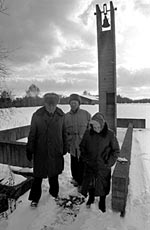
The only adult survivor of the massacre was a man called Joseph Kaminski

Although Joseph survived he had to suffer a hard blow, though. He found his injured son among the corpses of the fellow — villagers. The boy was fatally wounded in the abdomen and totally burnt. He died later in the arms of his father.
Two other Khatyn women survived because they were away from the village that day.
Tatyana Vasilyevna Karaban was visiting relatives in a neighboring village.
Sofya Klimovich, a relative of Tatyana Karaban, was also visiting a nearby village.
Although the inhabitants of Khatyn were not aware of the events which had unfolded that morning it didn’t stop the Nazi’s to indiscriminately kill everyone in the village, even a 7 week old baby wasn’t spared.
If it hadn’t been for the 6 witnesses who survived no one would have ever found out what really happened.
The commander of one of the platoons of 118th Schutzmannschaft Battalion, Ukrainian Vasyl Meleshko, was tried in a Soviet court and executed in 1975. The chief of staff of 118th Schutzmannschaft Battalion, Ukrainian Grigory Vassiura, was tried in Minsk in 1986 and found guilty of all his crimes. He was sentenced to death by the verdict of the military tribunal of the Belorussian military district.
The case and the trial of the main executioner of Khatyn was not given much publicity in the media; the leaders of the Soviet republics worried about the inviolability of unity between the Belarusian and Ukrainian peoples.
Khatyn became a symbol of mass killings of the civilian population during the fighting between partisans, German troops, and collaborators. In 1969, it was named the national war memorial of the Belarussian SSR. Among the best-recognized symbols of the memorial complex is a monument with three birch trees, with an eternal flame instead of a fourth tree, a tribute to the one in every four Belarusians who died in the war.There is also a statue of Joseph Kaminsky carrying his dying son
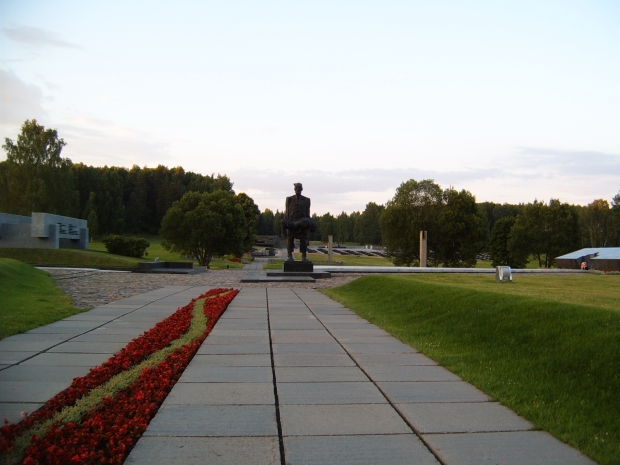
and a wall with niches to represent the victims of all the concentration camps, with large niches representing those with more than 20,000 victims.The Wall of Sorrow near the cemetery represents the memorial slabs with the names of 66 largest death camps and places of massive loss of life.
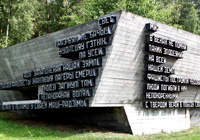
The memorial has 26 chimneys with bells – one for each of the houses in the village – which ring out every hour. Each chimney has a plaque remembering the family members who died.
Part of the memorial is a Cemetery of villages with 185 tombs. Each tomb symbolizes a particular village in Belarus that was fired along with its population.
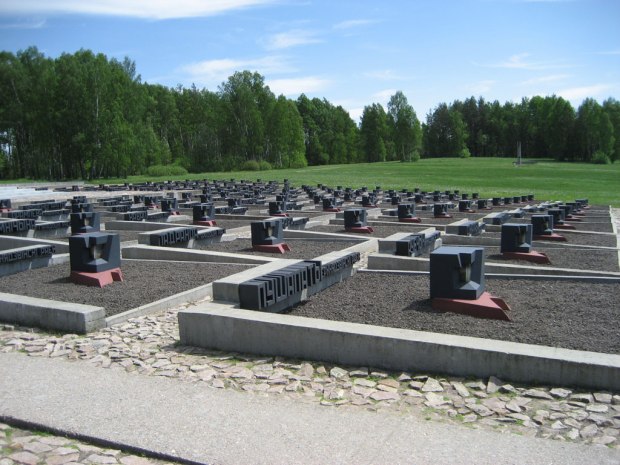
Among the foreign leaders who have visited the Khatyn Memorial during their time in office are Richard Nixon of the US, Fidel Castro of Cuba, Rajiv Gandhi of India, Yasser Arafat of the PLO, and Jiang Zemin of China.
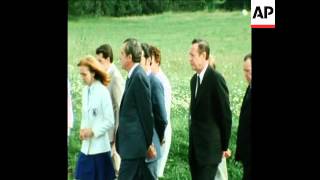
The Khatyn massacre was deliberately exploited to cover up the Katyn massacre by the Soviet authorities; according to Norman Davies, this was a major reason for erecting the memorial—it was done in order to cause confusion with Katyn among foreign visitors.
In 2004, the Memorial was renovated.

Nixon’s visit to the Memorial




